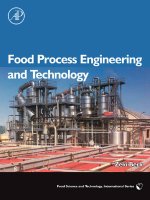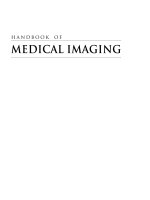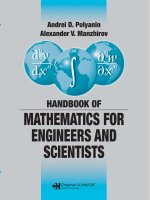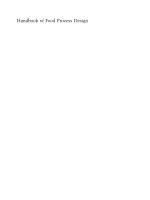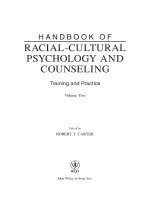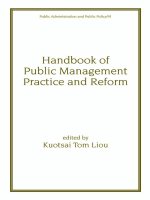Handbook of food process modeling and statistical quality control with extensive MATLAB applications by mustafa özilgen
Bạn đang xem bản rút gọn của tài liệu. Xem và tải ngay bản đầy đủ của tài liệu tại đây (25.05 MB, 690 trang )
Handbook of
Food Process Modeling
and
Statistical Quality Control
with Extensive MATLAB® Applications
S E C O N D
© 2011 by Taylor and Francis Group, LLC
E D I T I O N
© 2011 by Taylor and Francis Group, LLC
Handbook of
Food Process Modeling
and
Statistical Quality Control
with Extensive MATLAB® Applications
S E C O N D
E D I T I O N
Mustafa Özilgen
Boca Raton London New York
CRC Press is an imprint of the
Taylor & Francis Group, an informa business
© 2011 by Taylor and Francis Group, LLC
MATLAB® is a trademark of The MathWorks, Inc. and is used with permission. The MathWorks does not warrant the accuracy
of the text or exercises in this book. This book’s use or discussion of MATLAB® software or related products does not constitute endorsement or sponsorship by The MathWorks of a particular pedagogical approach or particular use of the MATLAB®
software.
CRC Press
Taylor & Francis Group
6000 Broken Sound Parkway NW, Suite 300
Boca Raton, FL 33487-2742
© 2011 by Taylor and Francis Group, LLC
CRC Press is an imprint of Taylor & Francis Group, an Informa business
No claim to original U.S. Government works
Printed in the United States of America on acid-free paper
10 9 8 7 6 5 4 3 2 1
International Standard Book Number: 978-1-4398-1486-4 (Hardback)
This book contains information obtained from authentic and highly regarded sources. Reasonable efforts have been made to
publish reliable data and information, but the author and publisher cannot assume responsibility for the validity of all materials
or the consequences of their use. The authors and publishers have attempted to trace the copyright holders of all material reproduced in this publication and apologize to copyright holders if permission to publish in this form has not been obtained. If any
copyright material has not been acknowledged please write and let us know so we may rectify in any future reprint.
Except as permitted under U.S. Copyright Law, no part of this book may be reprinted, reproduced, transmitted, or utilized in any
form by any electronic, mechanical, or other means, now known or hereafter invented, including photocopying, microfilming,
and recording, or in any information storage or retrieval system, without written permission from the publishers.
For permission to photocopy or use material electronically from this work, please access www.copyright.com ( or contact the Copyright Clearance Center, Inc. (CCC), 222 Rosewood Drive, Danvers, MA 01923, 978-750-8400.
CCC is a not-for-profit organization that provides licenses and registration for a variety of users. For organizations that have been
granted a photocopy license by the CCC, a separate system of payment has been arranged.
Trademark Notice: Product or corporate names may be trademarks or registered trademarks, and are used only for identification and explanation without intent to infringe.
Library of Congress Cataloging‑in‑Publication Data
Özilgen, Mustafa.
Handbook of food process modeling and statistical quality control / Mustafa Özilgen. ‑‑ 2nd ed.
p. cm.
Rev. ed. of: Food process modeling and statistical quality control. 1998.
Includes bibliographical references and index.
ISBN 978‑1‑4398‑1486‑4 (hardback) ‑‑ ISBN 978‑1‑4398‑1938‑8 (pbk.)
1. Food industry and trade‑‑Production control‑‑Mathematical models. 2. Food industry and
trade‑‑Quality control‑‑Statistical methods. I. Özilgen, Mustafa. Food process modeling and statistical
quality control. II. Title.
TP372.7.O95 2011
338.1’9‑‑dc22
Visit the Taylor & Francis Web site at
and the CRC Press Web site at
2011007241
To Sibel and Arda
© 2011 by Taylor and Francis Group, LLC
© 2011 by Taylor and Francis Group, LLC
Contents
Preface...............................................................................................................................................ix
Author............................................................................................................................................ xiii
1. Introduction to Process Modeling........................................................................................ 1
1.1 The Property Balance.................................................................................................... 1
1.2 What Is Process Modeling?......................................................................................... 14
1.3 Empirical Models and Linear Regression................................................................ 16
References................................................................................................................................ 36
2. Transport Phenomena Models............................................................................................ 39
2.1 The Differential General Property Balance Equation............................................. 39
2.2 Equation of Continuity................................................................................................ 40
2.3 Equation of Energy...................................................................................................... 48
2.4 Equation of Motion...................................................................................................... 48
2.5 Theories for Liquid Transport Coefficients.............................................................. 49
2.5.1 Eyring’s Theory of Liquid Viscosity............................................................. 49
2.5.2 Thermal Conductivity of Liquids................................................................. 53
2.5.3 Hydrodynamic Theory of Diffusion in Liquids......................................... 53
2.5.4 Eyring’s Theory of Liquid Diffusion............................................................54
2.6 Analytical Solutions to Ordinary Differential Equations...................................... 56
2.7 Transport Phenomena Models Involving Partial Differential Equations............ 70
2.8 Chart Solutions to Unsteady State Conduction Problems................................... 101
2.9 Interfacial Mass Transfer.......................................................................................... 108
2.10 Correlations for Parameters of the Transport Equations..................................... 113
2.10.1 Density of Dried Vegetables........................................................................ 113
2.10.2 Specific Heat.................................................................................................. 113
2.10.3 Thermal Conductivity of Meat................................................................... 114
2.10.4 Viscosity of Microbial Suspensions............................................................ 115
2.10.5 Moisture Diffusivity in Granular Starch................................................... 116
2.10.6 Convective Heat Transfer Coefficients during Heat Transfer to
Canned Foods in Steritort............................................................................ 116
2.10.7 Mass Transfer Coefficient k for Oxygen Transfer in Fermenters........... 117
2.11 Rheological Modeling............................................................................................... 124
2.12 Engineering Bernoulli Equation.............................................................................. 141
2.13 Laplace Transformations in Mathematical Modeling........................................... 151
2.14 Numerical Methods in Mathematical Modeling................................................... 158
References.............................................................................................................................. 183
3. Kinetic Modeling................................................................................................................. 187
3.1 Kinetics and Food Processing.................................................................................. 187
3.2 Rate Expression.......................................................................................................... 188
3.3 Why Do Chemicals React?........................................................................................ 197
3.4 Temperature Effects on Reaction Rates.................................................................. 200
vii
© 2011 by Taylor and Francis Group, LLC
viii
Contents
3.5
Precision of Reaction Rate Constant and Activation Energy
Determinations........................................................................................................... 202
3.6 Enzyme-Catalyzed Reaction Kinetics..................................................................... 205
3.7 Analogy Kinetic Models........................................................................................... 228
3.8 Metabolic Process Engineering................................................................................ 236
3.9 Microbial Kinetics...................................................................................................... 248
3.10 Kinetics of Microbial Death...................................................................................... 269
3.11 Ideal Reactor Design.................................................................................................. 282
References.............................................................................................................................. 306
4. Mathematical Modeling in Food Engineering Operations........................................ 309
4.1 Thermal Process Modeling....................................................................................... 309
4.2 Moving Boundary and Other Transport Phenomena Models for Processes
Involving Phase Change...........................................................................................343
4.3 Kinetic Modeling of Crystallization Processes...................................................... 389
4.4 Unit Operation Models.............................................................................................. 410
4.4.1 Basic Computations for Evaporator Operations....................................... 410
4.4.2 Basic Computations for Filtration and Membrane Separation
Processes........................................................................................................ 424
4.4.3 Basic Computations for Extraction Processes........................................... 450
4.4.4 Mathematical Analysis of Distilled Beverage Production
Processes........................................................................................................483
References..............................................................................................................................504
5. Statistical Process Analysis and Quality Control......................................................... 509
5.1 Statistical Quality Control........................................................................................ 509
5.2 Statistical Process Analysis...................................................................................... 511
5.3 Quality Control Charts for Measurements............................................................ 576
5.4 Quality Control Charts for Attributes.................................................................... 598
5.5 Acceptance Sampling by Attributes........................................................................ 608
5.6 Standard Sampling Plans for Attributes................................................................ 620
5.7 HACCP and FMEA Principles.................................................................................645
5.8 Quality Assurance and Improvement through Mathematical Modeling......... 656
References.............................................................................................................................. 677
Author Index................................................................................................................................ 681
Subject Index............................................................................................................................... 687
© 2011 by Taylor and Francis Group, LLC
Preface
It has been more than a decade since the first edition of this book appeared on shelves.
Paperback, hardbound, and e-book versions of the first edition were available in the market. More than 130 Internet booksellers included the first book on their lists; I was more
than happy with the welcome of the scientific community. Students who used the first
edition in their classes are now directors of major food establishments and, I am proud of
them all.
The second edition developed by way of an opportunity that presented itself. I taught
classes at the Massey University in New Zealand; we established our own company in
Ankara, Turkey. I chaired the Chemical Engineering Department, Yeditepe University in
Istanbul, where the most notable contributors were starting a PhD program and a food
engineering department. Teaching bioengineering classes to the genetic engineering
students was one of my most exciting experiences.
Turkey has the 18th largest economy in the world and the food industry makes up a big
part of it. There are about 45 food engineering departments in Turkish Universities. I was
honored to be among the founders of the first and 39th departments. The 39th department
was the first food engineering department in a foundation (private) Turkish university.
I appreciate the contributions of Seda Genc, Fatih Uzun, and all of my undergraduate
and graduate students, who helped to write the MATLAB® codes through their projects
or homework. I appreciate the help provided by Dr. Esra Sorguven of the Mechanical
Engineering Department of Yeditepe University, in the solutions of the examples involving the partial differential equation toolbox. I also appreciate the author’s license from
MATLAB® (MathWorks Book Program, A#: 1-577025751).
The second edition of the book is substantially different from the first edition in the
sense that
i.The title of the book is modified following the recommendations of experts
from academia and the industry. It is intended to present the book as a compendium of applications within its scope.
ii. The new edition covers extensive MATLAB applications. The model equations
are solved with MATLAB and the resulting figures are generated by the code.
The models are compared mostly with real data from the literature. Some errors
occurred while reading the data; therefore, the model parameters sometimes had
different values than those of the references.
iii.Tabular values and plots of mathematical functions are produced through
MATLAB codes.
iv. All of the MATLAB codes are given on the CD accompanying the book. A summary of the important features and functions of the MATLAB codes used in the
book are given in Table 1.1. The readers may refer to this table to locate the functions
or syntax they need. They may copy lines from the examples and write their own
code with them. I wrote my own codes by following this procedure. I would recommend achieving each task in the code in a stepwise manner and then going on
to the next task. Each task is usually defined in the examples with phrases such as
ix
© 2011 by Taylor and Francis Group, LLC
x
Preface
% enter the data, % plot the data, % modeling, % plot the model, etc. I tried to maintain
this order in the codes when possible.
v.A few food processing methods (i.e., pulsed electric field and high pressure processing)
gained importance after the first edition. Some examples are included to cover the
development.
vi. Feedback to the first edition indicated that simple models were welcomed, while
the sophisticated ones were avoided. The 80%–20% rule; that is, obtaining 80% of the
total possible benefits within the 20% of the highest difficulty level of the models continued
to be the motto. Examples to comprehensive and easy mathematical models with
sound theoretical background and a larger scope of application are given priority.
Using MATLAB helped to achieve this goal.
vii.It should be noted that this book was authored for educational purposes only. The
models were compared with real experimental data to make them as realistic as
possible. Some commercial applications, design, or research may need more accuracy, which is beyond the scope of this book.
viii.The statistical toolbox of MATLAB was used extensively in Chapter 5. In some
examples, relatively longer solutions were preferred to the shortcut alternatives
because of their educational value. Sampling methods with new acceptance were
published during the last decade. They are included in the book, while the older
practices were removed.
ix.I have gone through the files of classes that I have been teaching over the years
and added selected exam questions to the end of each chapter. The comprehension questions were designed to test the students’ understanding of the topics.
Correct answers to these questions are prerequisite for understanding the rest of
the material.
I will be more than happy to hear recommendations. I will evaluate them carefully to
make future editions of the book more useful.
Summary
The Handbook of Food Process Modeling and Statistical Quality Control is written along the
guidelines of the “80%–20% rule,” which means obtaining 80% of the total possible benefits within the 20% of the highest attainable modeling difficulty level. Fundamental
techniques of mathematical modeling of processes essential to the food industry are
explained in this text. Instead of concentrating on detailed theoretical analysis and mathematical derivations, important mathematical prerequisites are presented in summary
tables. Readers’ attention is focused on understanding modeling techniques, rather than
the finer mathematical points. Examples of comprehensive and easy mathematical models with sound theoretical background and a larger scope of application are given priority.
MATLAB has been used extensively to achieve this goal.
Topics covered include modeling of transport phenomena, kinetics, and unit operations
involved in food processing and preservation. Statistical process analysis and quality control as applied to the food industry are also discussed. The book’s main feature is the large
© 2011 by Taylor and Francis Group, LLC
Preface
xi
number of fully worked examples presented throughout. Included are examples from
almost every conceivable food process, most of which are based on real data provided
from numerous references. Each example is followed by a clear, step-by-step worked solution, and the associated MATLAB code.
Tabular values and plots of mathematical functions are also produced with MATLAB.
All of the codes are given in the CD accompanying the book. A summary of the MATLAB
functions and syntax used in the book are given in a table, so the readers will be able to
locate them easily. Most of the codes are written in the same sequential order and the readers are informed about them in the code with remarks like % enter the data, % plot the data,
% modeling, % plot the model, and so on. There are also in-depth explanations in the codes
to help readers understand them easily. Comprehension questions were added to each
chapter to test the students’ understanding of the topics.
This book contains 163 fully solved examples, 217 MATLAB codes (provided in full
detail), 273 figures (most of which are printouts of the codes), and 52 tables.
Mustafa Özilgen, PhD
Professor of Food Engineering
Yeditepe University
Istanbul, Turkey
MATLAB® is a trademark of The MathWorks, Inc. and is used with permission. The
MathWorks does not warrant the accuracy of the text or exercises in this book. This book’s
use or discussion of MATLAB® software or related products does not constitute endorsement or sponsorship by The MathWorks of a particular pedagogical approach or particular use of the MATLABđ software.
â 2011 by Taylor and Francis Group, LLC
© 2011 by Taylor and Francis Group, LLC
Author
Mustafa Özilgen is a chemical engineer. He has a BS and MS from the Middle East
Technical University in Turkey and a PhD from the University of California–Davis. He
is author or coauthor of numerous refereed publications and the author of two books.
The first edition of this book was published with the title Food Process Modeling and
Control, Chemical Engineering Applications (Gordon & Breach; Amsterdam, 1998). A recent
book authored by Professor Özilgen is Information Build-up During the Progression of
Industrialization (in Turkish, Arkadas Publishing Co., Turkey, 2009).
Mustafa Özilgen has taught numerous classes at the University of California–Davis,
Middle East Technical University, Ankara, Turkey, and the Massey University in New
Zealand. He was a member of the organizing committee and co-editor of the proceedings
of CHEMECA 1998, the annual Australian and New Zealander Chemical Engineering
conference. He also worked for the Marmara Research Center of Turkish Scientific and
Technical Research Center, Gebze. He was a recipient of one of the major research awards
offered by the Turkish Scientific and Technical Research Center in 1993. He is currently
working as a professor and chairperson of the Food Engineering Department at Yeditepe
University, Istanbul, Turkey.
xiii
© 2011 by Taylor and Francis Group, LLC
1
Introduction to Process Modeling
1.1 The Property Balance
Most of the mathematical models, which appear in the engineering literature, are based on
the balance of one or more conserved properties. The property balance starts after choosing an abstract or conceptual system. The universe, which remains outside of the system,
is referred to as the surroundings. The property balance around the system described in
Figure 1.1 may be stated as
input
rate of the
property
to the
system
output
rate of the
perty
− prop
from the
system
generation
rate of the
+ property
he
within th
system
consumption
rate of the
− property
within the
system
accumulation
rate of the
= property
within the
system
or
• + ψ•
•
•
ψ •in − ψ out
gen − ψ con = ψ acc ,
(1.1)
where:
ψ•in = rate at which an extensive property enters the system
ψ•out = rate at which an extensive property leaves the system
ψ•gen = rate at which an extensive property generated in the system
ψ•con = rate at which an extensive property consumed in the system
ψ•acc = rate at which an extensive property accumulates in the system.
In this formulation the input includes all extensive property that is added to the system
across the system boundary and the output describes the amount of extensive property
that leaves the system across the system boundary. Properties, like heat, may be transferred to or from the system without any material crossing the system boundary. The generation and the consumption terms describe the quantity of an extensive property that is
created or destroyed in the system, respectively.
In Equation 1.1 the “conserved property” Ψ may be total mass, an atom, a molecule, linear or angular momentum, total energy, mechanical energy, or charge. Property balances
1
© 2011 by Taylor and Francis Group, LLC
2
Handbook of Food Process Modeling and Statistical Quality Control, Second Edition
System
boundaries
+ generation
of the extensive
property
Extensive
property
input
– consumption
of the extensive
property
Extensive
property
output
Figure 1.1
Description of the system for the application of the conservation laws.
were performed for many centuries without recognizing their common nature. Newton’s
second law of motion, developed in 1687 to relate the net force on an object to its mass
and acceleration, is indeed an application of the conservation law to linear momentum.
It was one of the earliest examples to the conservation laws. The first law of thermodynamics is actually an energy balance, engineering Bernoulli equation that is used to
calculate energy dissipation by a liquid while flowing through a pipe and Kirchhoff’s
voltage law, which was formulated in 1845, are indeed different expressions for the
first law of thermodynamics. Kirchhoff’s current law, which states that the total charge
flowing into a node must equal the total charge flowing out of the node, is developed
on the concept of conservation of charge, and based on the same concept with the mass
balance.
We will use MATLAB® extensively to solve the equations resulting from the property
balances. The word MATLAB stands for matrix laboratory. The “Command Window” consists of a sequence of executable statements. It calls the built-in functions or the M-files and
executes them (MATLAB, Getting Started Guide 2008). Table 1.1 gives a list of the selected
examples where you may see the application of some skills, syntax, and functions in a
working code. You may refer to MATLAB help for further information.
MATLAB skills, syntax, and functions described in Table 1.1 are also used in numerous
other examples, which are not listed here. Tables 5.1, 5.2 and 5.3 provide more information about statistical MATLAB tools. Tables 2.10 through 2.17 provide more information
about MATLAB functions related with Bessel functions and error functions. Table 2.20
describes how to obtain the Laplace transforms by using the symbolic toolbox. In order
to get additional information about any topic covered in Table 1.1 (e.g., plotyy) type lookfor
plotyy or help plotyy or doc plotyy and enter while you are in the command window. You
may also search for MATLAB plotyy on the Internet; in addition to the large number of
documents provided by MATLAB and its users, you may join the forums where users
share information.
You may experience problems with the apostrophe ’. Although most of the computers
support the ASCII code apostrophes, there are some computers that do not. If you have
one of these computers, the apostrophe may appear on the screen, but the software may
not recognize it. If your code should not work because of this reason, get a working apostrophe from a running example and replace the nonworking ones by the copy and paste
method.
© 2011 by Taylor and Francis Group, LLC
3
Introduction to Process Modeling
Table 1.1
MATLAB® Skills, Syntax, and Functions Guide
Skills, Syntax, and Functions
Explanation and Examples to Refer
1. Plotting skills, syntax, and functions guide
plot
plot(B(1:4,3),D(1:4),’--*’) % plots first to fourth row, third column elements
of matrix B versus, from first to fourth elements of D vector. Notation ‘--*’
makes a dashed line with legend * at the data or computation points.
Example 1.1
plot(tData1,a,’x’,tData2,b,’o’); hold on, % plots a versus tData1 with legend
‘x’ and b versus tData2with legend ,’o’. Remark hold on makes the plot
wait for the execution of the next lines, so they are plotted together.
Example 1.4
f = [‘ro’, ‘bd’, ‘gv’, ‘ks’, ‘m*’]; % defines the color and the legends (ro is red
o, bd is blue diamond, gv is green triangle, ks is black square, m* is
magenta *)
hold on; plot(time, C, f((2*(6-i)-1):(2*(6-i)))); % makes the plot by using the
colors and the legends described by f. Example 3.11
plotyy
[AX,H1,H2] = plotyy(time, T(2,:), time, F(2,:)); hold on % prepare a plot with
y axis on both left- and right-hand sides. Example 4.10
semilogy
semilogy(tau,Lethalithy,’--’) % makes a semi log plot with y axis in log
semilogx
scale, x axis in linear scale, Example 4.6. Other option semilogx. Figure 3.5.
loglog
loglog(tData2,fData2, ‘x’); hold on % makes a plot with both x and y axis
are in log scale. Example 5.51
legend
legend(‘T fluid’,’T particle surface’,’T particle center’,’Location’,’West’)
% inserts a legend to the graph ‘Location’,’West’ describes the location
where you want to place the legend. Location options: East, West, South,
North, SouthEast, SouthWest, NorthEast, NorthWest, Best.
Example 4.10
legend(H2,’F particle surface’,’F particle center’,’Location’,’East’)
% insert a legend to the figure for the parameters in association with the
right-hand side y axis.
Example 4.10
figure
% if you should type figure in your code it will start a new figure.
figure
Example 2.1
xlim, ylim
ylim([0 5]); % limit of the range of the y axis
xlim([0 1000]); % limit of the range of the x axis
Example 4.11
ylim(AX(1), [80 140]) % limit of the range of the left-hand side y axis in
plotyy
ylim(AX(2), [0 40]) % limit of the range of the right-hand side y axis in
plotyy
Example 4.10
% REMARKS: Among other uses, xlim and ylim are needed when you plot
a few figures on top of each other (do not forget to use hold on, after each
plot). If you should not use xlim or ylim, each figure may set different
limits and you may not be able to compare the model with the data.
xlabel ylabel
xlabel(‘Time (s)’) % label for x axis
ylabel(‘Temperature \circ C’) % label for y axis
set(get(AX(2),’ylabel’), ‘string’, ‘F (min)’) % label for right-hand side y axis
in plotyy
Example 4.10
zlabel(‘cratio’) % z axis in a 3-D plot
Example 3.30
(Continued)
© 2011 by Taylor and Francis Group, LLC
4
Handbook of Food Process Modeling and Statistical Quality Control, Second Edition
Table 1.1 (Continued)
MATLAB® Skills, Syntax, and Functions Guide
Skills, Syntax, and Functions
line style
legend style
title
surface
colormap
grid
meshgrid
set(line…)
Explanation and Examples to Refer
plot(t,log(c(:,1)),’-’,t,log(c(:,2)),’:’); hold on % line style is described with ‘-’
(solid line) and ‘:’ (dashed line made of point). Other options are ‘--’
(dashed solid line) and ‘.-’ (dashed line with point and dash characters).
Example 3.1.
set(H1,’LineStyle’,’- -’) % line style of a property, which is related with the
left-hand side y axis in plotyy.
set(H2,’LineStyle’,’-’) % line style of a property, which is related with the
left-hand side y axis in plotyy.
Example 4.10
plot(tData,log(cData1),’s’,tData,log(cData2),’o’); hold on % ‘v’legends: ‘s’
square, ‘o’ o, other options are ‘v’ , ‘^’, ‘ < ’ , ‘ > ’ triangles, ,’d’ diamond, ‘p’
pentagene, ‘h’ hexagone, ‘x’, ‘ + ’ and ‘*’. Example 3.1
title(‘bar chart of the log cell areas’) % inserts a title to a plot. Example 5.2
surf(c11,c21,r21total); hold on % plots a surface in a 3-D plot. Example 3.15
colormap gray % sets the color of the surface, other options for gray are jet,
HSV, hot, cool, spring, summer, autumn, winter, bone, copper pink, lines.
Example 3.15
% inserts grids to a figure. Example 4.41
[e,t] = meshgrid(e,t);
% [X,Y] = meshgrid(x,y) transforms the x and y vectors into X and Y arrays,
which can be used to evaluate functions of two variables and threedimensional mesh/surface plots. Example 3.30
set(line([0 1],[0 1]),’Color’,[0 0 0]); % draws a line between points defined
by ([0 1],[0 1]). Color of the line is defined by ‘Color’,[0 0 0] (black). Other
alternatives are [1 1 0] yellow, [1 0 1] magenta, [0 1 1] cyan, [1 0 0] red, [0 1
0] green, [0 0 1] blue, [1 1 1] white. Example 4.41
2. Printing skills, syntax, and functions guide
fprintf
% fprintf writes formated data.
fprintf(‘Waxy rice starch contains 100 %% Amylopectin and 0 %%
Amylose’) % prints the characters between ‘ ‘.
fprintf(‘\nTotal bond energy of the waxy rice starch is %.2g kJ/
mol’,Energy) % prints the characters between ‘ ‘ and value of variable
Energy to the location marked as %.2g (number before . describes the field
length, number after . describes the precision alternatives to g are c
character, f fixed point, e exponential notation). Example 1.1
% tabulate the data:
fprintf(‘\nAge and fraction of the liquid pockets\n\n’)
fprintf(‘ t(s) Fraction\n’)
fprintf(‘----------- -----------\n’)
for i = 1:11
fprintf(‘%-15g %7g\n’,a(i,1), a(i,4))
end
% \n means skipping a line the number of \‘s defines the number of the
lines to be skipped. Example 3.11
display
% display(X) prints the value of a variable or expression, X.
display(z1); Example 5.5
© 2011 by Taylor and Francis Group, LLC
5
Introduction to Process Modeling
Table 1.1 (Continued)
MATLAB® Skills, Syntax, and Functions Guide
Skills, Syntax, and Functions
Explanation and Examples to Refer
3. Line and curve fitting skills, syntax, and functions guide
polyfit
c = polyfit(tData,xDataFreeMoisture,N) % fits a Nth order polynomial to the
data. Example 4.12
nlinfit
beta = nlinfit(x,y,fun,beta0) % returns a coefficients vector beta for nonlinear
regression, y is the dependent variables vector, x is dependent variables
vector, beta0 is the vector of the initial estimates of beta. Notice: beta may
depend on beta0. Examples 2.7, 4.7
lsline
% after plotting a linear data if you should write lsline least squares line
will be plotted. Example 1.3
polyval
xModel = polyval(c,tModel); % returns the value of a polynomial of degree
n evaluated at tModel. The input argument c is a vector of length n + 1
whose elements are the coefficients in descending powers of the
polynomial to be evaluated.
xModel = c(1)tModeln + c(2)tModeln–1 + … + c(n + 1)
Example 4.12
4. Mathematical functions and operations skills, syntax, and functions guide
sum
sum_xi = sum(xi); % sum all xi values
Example 1.2
mean
DeffAvg50 = mean(Deff50); % mean of Deff50 values
Example 4.34
factorial
Pa2 = (factorial(n)/(factorial(x)*factorial(n-x)))*(p^x)*(1-p)^(n-x);
% factorial(n) is the product of all the integers from 1 to n, i.e. prod(1:n).
The answer is accurate for n < = 21. Example 5.35
square root
Se = sqrt(mean(d2)); % square root of mean of d2 values
Example 2.15
range
% y = range(x) returns the range of the values in x. Example 5.16
error function
c(j,k) = c1 + (c0-c1)*erf(z) ; % erf(z) error function of z. Example 2.13
complementary error
error_func(i) = erfc(L/(2*sqrt(a*times(i)))); % complementary error
function
function of (L/(2*sqrt(a*times(i))). Example 4.5
Bessel function
s(n) = exp(-(alpha* time(j)/(Radius^2))*(Bn(n)^2))*besselj(0,z)/
((Bn(n)^2)*besselj(1,Bn(n))); % besselj(0,z) zero order Bessel function
evaluated at z, besselj(1,Bn(n)) first order Bessel function evaluated at
Bn(n). Example 2.10
complementary Bessel
K14_besselfunction(i) = besselk(0.25,(R^2)/(8*a*times(i)));
function
% K1/4 is the modified Bessel function of the second kind of order ¼.
Example 4.5
integral
NTU = quad(@calculateNTU,yB,yA) % quad computes the integral
described by function ‘calculate’ between the limits yB and yA with
fourth order Runge-Kutta method. Example 4.39
fminsearch
Lmin = fminsearch(y,5); % starts at 5 and attempts to find a minimizer
Lmin of y. Example 5.54
ceil
B = ceil(A); % rounds the number A toward plus infinity (the other
round
alternatives are B = round(A), which rounds A to the nearest integer or
floor
B = floor(A), which rounds A to the nearest integers less than or equal to
fix
A, B = fix(A) rounds the elements of A toward zero). Example 5.54
(Continued)
© 2011 by Taylor and Francis Group, LLC
6
Handbook of Food Process Modeling and Statistical Quality Control, Second Edition
Table 1.1 (Continued)
MATLAB® Skills, Syntax, and Functions Guide
Skills, Syntax, and Functions
Explanation and Examples to Refer
5. Statistical functions skills, syntax, and functions guide
correlation coefficient
rmatrix = corrcoef(lnXdata1,tData1); % find the correlation coefficient
matrix of the data given in vectors lnXdata and tData1
r = rmatrix(1,2); % convert the correlation coefficient matrix into a single
number. Example 2.15
standard error
% determine the standard error
for j = 1:1:size(tData1);
lnXmodel = lnX0-K*tData1;
d1 = (lnXdata1-lnXmodel);
d2 = d1*d1’;
end;
Se = sqrt(mean(d2));
Example 2.15
hypothesis testing concerning
H = ztest(xBarExp,mu,sigma)
one mean
% where xBar is the sample mean and sigma is the population standard
deviation. The outcome H = 0 indicates that the hypothesis cannot be
rejected, the outcome H = 1 indicates that the null hypothesis can be
rejected. Example 5.14
hypothesis testing concerning
% refer to Example 5.15
two means when the
population standard
deviations are known
binocdf
% y = binocdf(x,n,p) returns the binomial cumulative distribution function
with parameters n and p at the values in x.
ATI2 = n + (N-n)*(1-binocdf(c,n,p)); Example 5.54
normcdf
% p = normcdf(x,mu,sigma) returns the cumulative distribution function of
the normal distribution with mean mu and standard deviation sigma,
evaluated at the values in x.
fModel2 = normcdf(log(t),lnMuTemp2,sigma); Example 5.51
anova1
% (anova one means one way of analysis of variance)
p = 100*anova1(x,[ ], ‘off’); % p = probability of having the rows of matrix x
be the same. Example 5.25
anova2
% [p,table] = anova2(...) returns two items where p is a vector of p-values
for testing column, row, and if possible interaction effects, table is a cell
array containing the contents of the anova table.
[p Table] = anova2(x,1, ‘off’) Example 5.26
vartest2
H = vartest2(X,Y) performs an F test of the hypothesis that two independent
samples, in the vectors X and Y, come from normal distributions with the
same variance
H = vartest2(Vjuice,Vbeverage,alpha) Example 5.24
normspec
normspec(specs,mu,sigma,region) % shades the region either ‘inside’ or
‘outside’ the specification limits.
Figure 5.2.
6. Solution of algebraic, ordinary, and partial differential equations
division of matrices, solution
H = D./MM;
of set of linear algebraic
Example 1.1
equations
fzero
xe(i) = fzero(‘EthanolEquilibrium’,0.5); % finds the value of the independent
variable xe, which makes the value of the function
‘EthanolEquilibrium’,zero. around xe = 0.5. Example 4.41
© 2011 by Taylor and Francis Group, LLC
7
Introduction to Process Modeling
Table 1.1 (Continued)
MATLAB® Skills, Syntax, and Functions Guide
Skills, Syntax, and Functions
ode45
pdepe
pdetoolbox
Explanation and Examples to Refer
% ode45 solves the ordinary differential equations.
[t,c] = ode45(@ascorbicacid1,tspan,c0); solves the ordinary differential
equation described in the m-function ‘ascorbicacid1’ tspan is the time span
(time from beginning to end, you may also enter a time matrix) of the
solution, c0 is the initial condition. The solution returns t and c values,
which are given on the left-hand side of the syntax. Example 3.1.
% we may also use ode45 to solve a set of simultaneous ordinary
differential equations. Example 3.4
sol = pdepe(m,@pdex1pde,@pdex1ic,@pdex1bc,r,t);
% solves initial-boundary value problem defined in m-function ‘pdex1pde’
with the initial condition defined in function ‘pdex1ic’ with the boundary
conditions defined in function ‘pdex1bc’. m = 2 for the given problem,
r = computation points along the radius, t = time matrix. Example 4.20
% The Partial Differential Equation Toolbox contains tools for solution of
partial differential equations in 2-D space and time. A set of command-line
functions and a graphical user interface let you preprocess, solve, and
postprocess generic 2-D PDEs. Example 4.16
Example 1.1: Application of the First Law of Thermodynamics to Nutrition
Equation E.1.1.1 may be used to describe the conservation of energy around the system boundaries
(Figure E.1.1.1) after substituting
ψ m• = min• (u + ep + k + Pν)in + Q ,
(E.1.1.1)
• (u + e + k + Pν)
ψ •out = mout
p
out ,
(E.1.1.2)
and
ψ •acc =
d
msyst (u + ep + k )syst ,
dt
(E.1.1.3)
where m• is the mass flow rate, u is the internal energy per unit mass, ep is the potential energy per
unit mass, and k is the kinetic energy per unit mass. The term Q represents the heat entering into
the system without being associated with the incoming mass.
Internal energy is associated with the energy stored in the atomic and the molecular structure.
Potential energy is associated with the position of an object with respect to a reference position.
The term Pν is the pressure–volume work describing the work done by the molecules behind a
specific molecule that pushes it into or out of the system, where P is the pressure and ν is the
volume per unit mass of the fluid. Heat transfer with conduction, convection, or radiation may
be achieved independent of the mass influx or out flux from the system. Therefore the term Q
appears as a separate entity in Equation E.1.1.1. If the system consumes energy by performing
work, the term ψ •con of the general property balance equation E.1.1.1 may be described as
© 2011 by Taylor and Francis Group, LLC
ψ •con = W.
(E.1.1.4)
8
Handbook of Food Process Modeling and Statistical Quality Control, Second Edition
Heat received
by the system
System
boundaries
Consumption
of energy by
doing work
Energy
output
with
outgoing
stream
Energy
input
with
incoming
stream
Figure E.1.1.1
Description of the system for conservation of energy.
After substituting Equations E.1.1.1 through E.1.1.4 in Equation 1.1 we will obtain the first law of
thermodynamics as
d
m• (u + ep + k + Pν)in − m• (u + ep + k + Pν)out + Q − W = macc (u + ep + k )acc (E.1.1.5)
dt
Organisms store internal energy, u, within their structures. High energy bonds of the fat and starch
molecules are the most common energy reserves of the animal and the plant cells, respectively.
These bonds are broken to release their energy to achieve the biological processes. Energy and the
number of the interatomic bonds of some common fatty acids are given in Table E.1.1.
a. Starch is produced as granules in the plants cells. All granules consist of amylose and amylopectin in percentages that change with the source. About 1000–4000 glucose units are linked with
α-(1→4) bonds to make amylose. There are about 2000–20,000 α-(1→4) linked glucose units
in amylopectin. There is also one residue in about every 20 glucose units linked with α-(1→6)
bonds and form the branch points in amylopectin. Amylose is made up of between 1000 and
4400 and amylopectin is formed of 2000–200,000 glucose units. MATLAB® code E.1.1.a computes the total bond energy of starch molecules originating from waxy rice (code 1), rice (code
2), cassava (code 3), corn (code 4), wheat (code 5), and sweet potato (code 6). In order to run
this m-function, after saving it in your computer, go to the command window, type starch, enter
it. You will be asked to enter the code of the starch of interest. Enter it. The total bond energy of
the specified starch with 10,000 glucose monomers will appear on the screen.
b. Calculate the total bond energy of each fatty acid.
We may describe the total bond energy of the fatty acids in matrix form as
T
D = B C .
Where corresponding elements of |B| and |C| give the number and the energy of the bonds
in one mole of a fatty acid. Matrix |D| gives the total bond energy of each fatty acid stated in
|A|. MATLAB® code E.1.1.b is employed to print out the total bond energy of the fatty acids.
The total bond energy of the fatty acids is also plotted as a function of their C–H bonds. The
bond energy of 17 C containing fatty acids are also plotted as a number of the C = C bonds
in their structure.
c. When a 70 kg person runs at a speed of 10 km/hour, he burns 50 kJ in a minute. Determine
how many grams of each fatty acid he consumes in 1 h.
(E.1.1.6)
© 2011 by Taylor and Francis Group, LLC
9
Introduction to Process Modeling
Table E.1.1
Molar Mass, Number of the Interatomic Bonds/Molecule, and Energy/Bond of the Glucose Units
of Starch and Fatty Acids
BOND and its Energy
(kJ/mol)
→
Molar mass
↓
C = C (cdc)
606
C–C (cc)
334
C–H (ch)
410
C = O (cdo)
723
O–H (oh)
456
C–O (co)
330
Number/
Molecule
↓
Number/
Molecule
↓
Number/
Molecule
↓
Number/
Molecule
↓
Number/
Molecule
↓
Number/
Molecule
↓
0
6
5
0
2
4
0
7
7
0
4
5
0
0
0
0
1
11
13
15
17
14
23
27
31
35
29
1
1
1
1
1
1
1
1
1
1
1
1
1
1
1
1
16
33
1
1
1
2
3
15
14
31
29
1
1
1
1
1
1
Glucose in amylose 180
(g/mole)
Glucose in amylopectin
180 (g/mole)
Lauric acid 200 (g/mole)
Myristic acid 228 (g/mole)
Palmitic acid 257 (g/mole)
Stearic acid 285 (g/mole)
Palmitoleic acid 299 (g/
mole)
Oleic acid
283 (g/mole)
Linoleic acid 281 (g/mole)
Linolenic acid 278 (g/
mole)
MATLAB® CODE E.1.1.a
M-File:
function starch
disp({‘1. Waxy Rice’;’2. Rice’;’3. Corn’;’4. Cassava’;’5. Wheat’;’6.
Sweet Potato’;});
EN = [410 334 330 456];
BRAMILO = [5 6 4 2];
AMILO = [7 7 5 4];
choice = input(‘Please enter the code of the source of the starch:
‘,’s’);
switch choice
case ‘1’
n = 10000/25;
Energy = n*sum(EN*BRAMILO’)+ (10000-n)*sum(EN*AMILO’);
fprintf(‘Waxy rice starch contains 100 %% Amylopectin and 0 %%
Amylose’)
fprintf(‘\nTotal bond energy of the waxy rice starch is %.2g kJ/
mol’,Energy)
case ‘2’
n = 8000/25;
Energy = n*sum(EN*BRAMILO’) + (8000-n)*sum(EN*AMILO’) +
2000*sum(EN*AMILO’);
© 2011 by Taylor and Francis Group, LLC
10
Handbook of Food Process Modeling and Statistical Quality Control, Second Edition
fprintf(‘Rice starch contains 80 %% Amylopectin and 20 %% Amylose’)
fprintf(‘\nTotal bond energy of the rice starch is %.2g kJ/
mol’,Energy)
case ‘3’
n = 7200/25;
Energy = n*sum(EN*BRAMILO’) + (7200-n)*sum(EN*AMILO’) +
2800*sum(EN*AMILO’);
fprintf(‘Corn starch contains 72 %% Amylopectin and 28 %% Amylose’)
fprintf(‘\nTotal bond energy of the corn starch is %.2g kJ/
mol’,Energy)
case ‘4’
n = 8300/25;
Energy = n*sum(EN*BRAMILO’) + (8300-n)*sum(EN*AMILO’) +
1700*sum(EN*AMILO’);
fprintf(‘Cassava starch contains 83 %% Amylopectin and 17 %% Amylose’)
fprintf(‘\nTotal bond energy of the cassava starch is %.2g kJ/
mol’,Energy)
case ‘5’
n = 7400/25;
Energy = n*sum(EN*BRAMILO’) + (7400-n)*sum(EN*AMILO’) +
2600*sum(EN*AMILO’);
fprintf(‘Wheat starch contains 74 %% Amylopectin and 26 %% Amylose’)
fprintf(‘\nTotal bond energy of the wheat starch is %.2g kJ/
mol’,Energy)
case ‘6’
n = 8200/25;
Energy = n*sum(EN*BRAMILO’) + (8200-n)*sum(EN*AMILO’) +
1800*sum(EN*AMILO’);
fprintf(‘Sweat potato starch contains 82 %% Amylopectin and 18 %%
Amylose’)
fprintf(‘\nTotal bond energy of the sweat potato starch is %.2g kJ/
mol’,Energy)
otherwise
disp({‘Unknown Starch!!! Please retry!!’;})
end
A sample run of the code is given here:
‘1. Waxy Rice’
‘2. Rice’
‘3. Corn’
‘4. Cassava’
‘5. Wheat’
‘6. Sweet Potato’
Please enter the code of the source of the starch: 5
Wheat starch contains 74 % Amylopectin and 26 % Amylose
Total bond energy of the wheat starch is 8.6e + 007 kJ/mol
© 2011 by Taylor and Francis Group, LLC
Introduction to Process Modeling
MATLAB® CODE E.1.1.b
Command Window:
clear all
close all
% enter the fatty acid names as characters
A = char(‘Lauric Acid’, ‘Myristic Acid’, ‘Palmitic Acid’, ‘Stearic
Acid’, ‘Palmioletic Acid’, ‘Oleic Acid’, ‘Linoleic Acid’, ‘Linolenic
Acid’);
% enter the number of the C = C bonds, C-C bonds, C-H bonds, C = O
bonds, O-H bonds, and C-O bonds as the rows of a matrix
B = [ 0 11 23 1 1 1; 0 13 27 1 1 1; 0 15 31 1 1 1; 0 17 35 1 1 1; 1
14 29 1 1 1; 1 16 33 1 1 1; 2 15 31 1 1 1; 3 14 29 1 1 1];
C = [606 334 410 723 456 330]; % bond energies of the C = C, C-C, C-H,
C = O, O-H and C-O bonds
% compute the molar bond energy of each fatty acid
D = B*C’;
% tabulate the results:
fprintf(‘\nBond energy of the fatty acids\n\n’)
fprintf(‘Fatty acid Bond energy (J/mole)\n’)
for i = 1:8
fprintf(‘%-15s %8d\n’,A(i,:), D(i))
end
plot(B(1:4,3),D(1:4),’--*’) % plot the molar bond energy of a fatty
acid as a function of the number of the C-H bonds in the saturated
fatty acids (‘Lauric Acid’, ‘Myristic Acid’, ‘Palmitic Acid’,
‘Stearic Acid’)
xlabel(‘number of the C-H bonds in a saturated fatty acid’)
ylabel(‘Molar bond energy (J/mol)’)
j = 1;
for i = 1:8
k = B(i,1) + B(i,2);
if k = = 17
E(j,1) = j-1;
E(j,2) = D(i);
j = j + 1;
end
end
figure
plot(E(1:4,1),E(1:4,2),’--*’)
xlabel(‘number of the C = C bonds in a 17 C fatty acid’)
ylabel(‘Molar bond energy (J/mol)’)
© 2011 by Taylor and Francis Group, LLC
11
